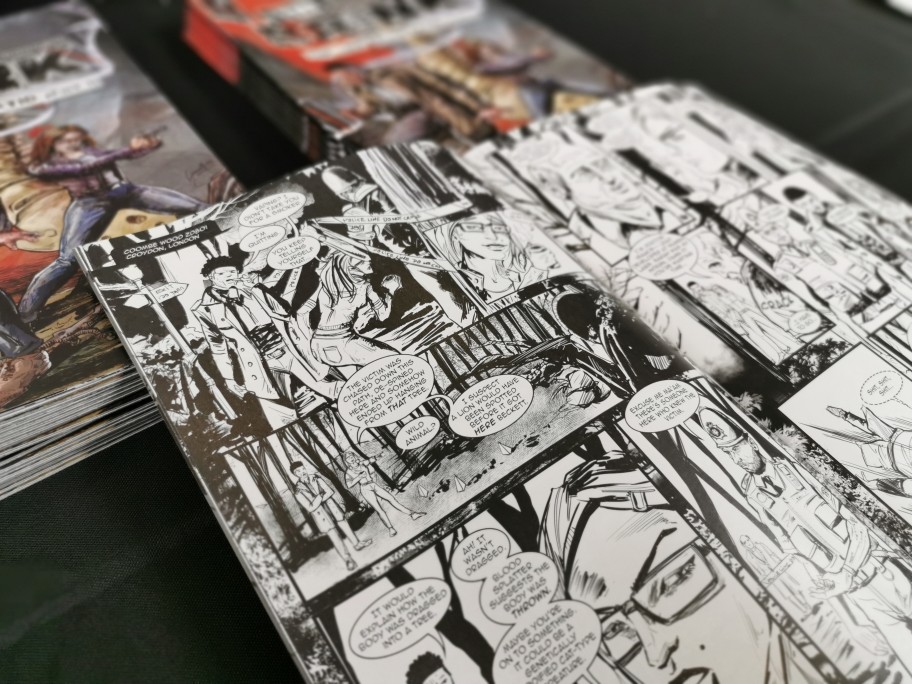I enjoyed comic books as a kid. I used to read Judge Dredd and really liked the artistry and work that goes into it. But it has only really been the last ten years that I really appreciated them. I particularly like The Walking Dead, Black Magik and Rick and Morty. I also began reading Gasolina and The Chair.
I’m not a professional artist, but I could begin drawing the comic myself. However, I realised that would take me a lot longer and what I had in mind was beyond my artistic skill level. So, I decided to find an artist.
But wait, before I go about fidning an artist, I should learn how to write for a comic book, right? Yes, that would be sensible. However, in my case, I found an artist first – Marcelo Simonetti from Uruguay – and he helped me understand how different writing a comic book really is.
Please note, hiring an artist costs money. Anywhere in excess of £70 per page for pencil and ink, more for colour and more for a comic book cover. It depends on the skill and experience of your artist.
It's worth a note that it is an expensive hobby. I’m paying for a highly skilled artist with years of experience and I soaked up some of that experience myself. So, in a sense, it was like an educational course to better myself. I contemplated asking for help on Kickstarter but at that stage, I didn't have a clue about managing a whole kickstarter campaign.
Research
I had to do a small amount of research on writing for a comic book before diving in – of course I read that you should provide a script for your artist. This is probably quite obvious but it wasn’t until I began working with Marcelo that I realised that it was not a simple process. I could’ve just given him a half-assed script and left it up to him to work it out. He’d probably have alot of questions for me and in the end I don’t think the working relationship would have been great. The end product would no doubt be good because the art would be, but the depth in story just wouldn’t be there. Also, the art may not even be what I envisioned. I don’t want to write a comic book for the sake of saying I’ve written a comic, I want it to be good with plenty for the reader to ponder and leave them wanting more.
Planning
Initially, I unwittingly abandoned the usual process I go through when I write because writing for a comic book felt like it should be easier. Just to set the record straight, it’s not easy. In some ways it is more fun, but this is not something you can just throw together – it takes quite abit of thought and care which involves setting goals, which I’ll talk about another time.
The stories I'd already written didn’t fit perfectly into comic format. So, I spent alot of time modifying my story. However, what works well, and always has for me, was beginning with a simple plot. I just write a few sentences of what the story is about…
For example.. "A series of weird murders calls for the expertise of two specialist detectives to solve". Simple.
The plot
Then I write the plot in bullet point format. At this point there isn’t any dialogue, just an idea of what will happen.
For example..
- A girl is running away from something in the woods.
- It catches up with her and tears out her spine.
- The main characters meet for the first time and go over the facts of the case.
- They visit the scene.
It’s very basic to begin with, but this really helps me make sense of any complex situations I have in my mind. I also plan long term story arcs and include them in the plot overview where I need too. Having it written down in this way is useful for me to look back on. Some may use post-it notes.
I just get my ideas and plot down in the form of a list. I don't even think about trying to fit it into a 22 page comic book at this point, but I ensure the plot makes sense. It turns out that my plot for the detectives first case actually spanned a few comic book issues and that’s OK.
I then started to add further details and expand the list with information on locations and a little more on what the characters talk about. I could then start to think about the layout of my comic…
Go to www.brinkcasefiles.com to see my comic.I’ll write another blog about what I did to create the comic book layout and what I found out about panels. Hopefully you found this useful.





